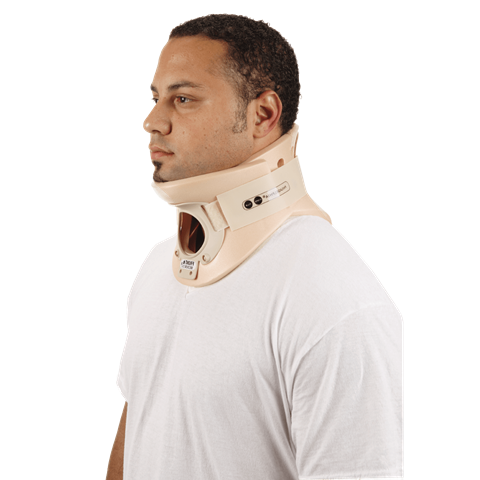
Ossur
Philadelphia® Tracheotomy Collar
- Anterior and posterior rigid plastic reinforcement supports limit movement. Total cervical arch support maintains neutral alignment of the cervical spine
- Water-resistant for bathing and aqua-therapy
- Easily customized for individual requirements
- Latex-free, non-toxic and hypoallergenic Plastazote® foam reduces skin irritation
- Anterior and posterior rigid plastic reinforcement supports limit movement. Total cervical arch support maintains neutral alignment of the cervical spine
- Water-resistant for bathing and aqua-therapy
- Easily customized for individual requirements
- Latex-free, non-toxic and hypoallergenic Plastazote® foam reduces skin irritation
Collar Studies
Range-of-Motion Restriction and Craniofacial Tissue-Interface Pressure From Four Cervical Collars
Ann N. Tescher, RN, PhD, CNS; Aaron B. Rindflesch, PT, PhD; James W. Youdas, PT; Therese M. Jacobson, RN, CNS; Lisa L. Downer, RN, CNS; Anne G. Miers, RN, CNS; Jeffrey R. Basford, MD, PhD; Daniel C. Cullinane, MD; Susanna R. Stevens, MS; V Shane Pankratz, PhD; Paul A. Decker, MS
Journal of Trauma-Injury Infection & Critical Care: November 2007 - Volume 63 - Issue 5 - pp 1120-1126
Abstract:
Background: Occipital pressure ulcers are well-known complications for trauma patients wearing cervical collars. We assessed the effects of four commercial cervical collars (Aspen, Philadelphia, Miami J, and Miami J with Occian back [Miami J/Occian]) on cervical range of motion (CROM) and mandibular and occipital tissue-interface pressure (TIP).
Methods: Forty-eight healthy volunteers (24 men, 24 women; mean age, 38.9 years +/- 10.5 years) were stratified by body mass index. CROM was measured in the seated position without and with collars. Sagittal, coronal, and rotatory CROM was measured with a goniometer. Occipital and mandibular pressures were mapped with subjects in upright and supine positions.
Results: All collars significantly restricted CROM in all planes (p < 0.001). The Philadelphia and standard Miami J collars were the most restrictive. The Aspen collar was the least restrictive for flexion and rotation. The Miami J/Occian back was the least restrictive for extension and lateral flexion. For supine measurements, Miami J and Miami J/Occian back had the lowest mean TIP, whereas Aspen and Philadelphia collars had the greatest (p < 0.001). For upright measurements, the Miami J/Occian back produced the smallest mean TIPs; the other collars, ranked by ascending TIP, were Philadelphia, Miami J, and Aspen (p < 0.001). Philadelphia and Miami J collars had significant collar-body mass index interaction effects on supine occiput mean pressure (p = 0.04).
Conclusions: Miami J and Philadelphia collars restricted CROM to the greatest extent. Miami J and Miami J/Occian back had the lowest levels of mandibular and occipital pressure; these collars may markedly reduce the risk of occipital pressure ulcers without compromising immobilization.
(C) 2007 Lippincott Williams & Wilkins, Inc.
- Full article can be found on The Journal of Trauma website
Improving Practice
Efforts to Reduce Occipital Pressure Ulcers
Therese M. Jacobson, MSN, CNS, CWOCN; Ann N. Tescher, PhD, RN, CCRN, CCNS; Anne G. Miers, MSN, CNS, CNRN; Lisa Downer, MSN, CNS
St. Mary’s Hospital,Mayo Clinic Rochester, Minnesota. Published in Journal of Nursing Care Quality, 2008 Vol. 23, No. 3, pp. 283–288
Abstract:
Cervical collars are necessary to stabilize the cervical spine of trauma patients but are known to contribute to the development of occipital pressure ulcers. A quality improvement project that began on one nursing unit stimulated the development of evidence-based practice guidelines and a multidisciplinary research study. As a result, a standardized plan of care and cervical collar recommendations were implemented, resulting in a sharp decline in the incidence of occipital pressure ulcers.
Results: “On the basis of the study’s findings, it was recommended that the Miami J collar be used as the standard cervical collar for trauma patients and that the Occian Back of the Miami J collar be used when patients were on strict spine precautions or bed-rest. Implementation occurred during first quarter of 2006 and resulted in an 89% reduction in the incidence of occipital pressure sores in 2006 as compared to 2005”. (p. 287)
SORBATEX™
In independent university testing, the Sorbatex Miami J Collar pads outperformed the leading competitive cotton/foam laminated pad.
Information from Grundy Laboratory Report: “Comparison Study of Miami J Collar Pads with Cotton/Foam Collar Pads,” Philadelphia College of Textiles & Science, 1997.
Order Information
Philadelphia Tracheotomy Collar
| Part# | Height | Size | Circ. |
|---|---|---|---|
| PHP-TI | 1.25" | Infant | 6-8" |
| PHP-TP | 1.75" | Pediatric | 8-11" |
| PHP-T2XS | 2.25" | XSmall | Up to 10" |
| PHP-TxS | See footnote | Small | 10-13" |
| PHP-TxM | See footnote | Medium | 13-16" |
| PHP-TxL | See footnote | Large | 16-19" |
| PHP-TxXL | See footnote | XLarge | 19" up |
| x = 2 (2.25" height); 3 (3.25" height); 4 (4.25" height); or 5 (5.25" height) | |||
CoolMax® Liners
| Part# | Description |
|---|---|
| PHP-LCI | Infant |
| PHP-LCP | Pediatric Sizes |
| PHP-LCXS | XSmall Sizes |
| PHP-LCS | Small Sizes |
| PHP-LCM | Medium Sizes |
| PHP-LCL | Large Sizes |
| PHP-LCXL | XLarge Sizes |
|
|
|
|
